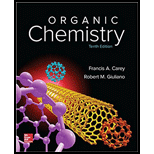
ORGANIC CHEMISTRY (LOOSELEAF)-PACKAGE
10th Edition
ISBN: 9781260008562
Author: Carey
Publisher: MCG
expand_more
expand_more
format_list_bulleted
Concept explainers
Textbook Question
Chapter 17, Problem 40P
Write a mechanism for the following reaction.

Expert Solution & Answer
Want to see the full answer?
Check out a sample textbook solution
Students have asked these similar questions
Draw the most likely mechanism for the following
d.
'Ph
Draw the most likely mechanism for the following
Chapter 17 Solutions
ORGANIC CHEMISTRY (LOOSELEAF)-PACKAGE
Ch. 17.1 - Prob. 1PCh. 17.2 - The heats of combustion of 1, 2-epoxybutane...Ch. 17.3 - Prob. 3PCh. 17.4 - Prob. 4PCh. 17.5 - Prob. 5PCh. 17.6 - Problem 17.6 (a) Write equations describing two...Ch. 17.6 - Problem 17.7 Only one combination of alkyl halide...Ch. 17.6 - Prob. 8PCh. 17.8 - Prob. 9PCh. 17.8 - Prob. 10P
Ch. 17.9 - Prob. 11PCh. 17.10 - Problem 17.12 Classify the bromohydrins formed...Ch. 17.11 - Prob. 13PCh. 17.11 - Prob. 14PCh. 17.12 - Prob. 15PCh. 17.12 - Prob. 16PCh. 17.14 - Prob. 17PCh. 17.15 - Prob. 18PCh. 17.16 - Prob. 19PCh. 17.17 - Problem 17.20 There is another oxygen-stabilized...Ch. 17 - Prob. 21PCh. 17 - Many ethers, including diethyl ether, are...Ch. 17 - Although epoxides are always considered to have...Ch. 17 - The name of the parent six-membered...Ch. 17 - Prob. 25PCh. 17 - Prob. 26PCh. 17 - Prob. 27PCh. 17 - Prob. 28PCh. 17 - Prob. 29PCh. 17 - Given that: does the product of the analogous...Ch. 17 - Prob. 31PCh. 17 - Prob. 32PCh. 17 - Prob. 33PCh. 17 - Prob. 34PCh. 17 - Prob. 35PCh. 17 - Prob. 36PCh. 17 - When (R)-(+)-2-phenyl-2-butanol is allowed to...Ch. 17 - Prob. 38PCh. 17 - Prob. 39PCh. 17 - Write a mechanism for the following reaction.Ch. 17 - Prob. 41PCh. 17 - Prob. 42PCh. 17 - Prob. 43PCh. 17 - Prob. 44PCh. 17 - Prob. 45PCh. 17 - Prob. 46DSPCh. 17 - Prob. 47DSPCh. 17 - Prob. 48DSPCh. 17 - Prob. 49DSPCh. 17 - Epoxide Rearrangements and the NIH Shift This...Ch. 17 - Epoxide Rearrangements and the NIH Shift This...
Knowledge Booster
Learn more about
Need a deep-dive on the concept behind this application? Look no further. Learn more about this topic, chemistry and related others by exploring similar questions and additional content below.Similar questions
- a. OH H₂N-O -Ph H+ acyclic productarrow_forwardeks.com/aleksogi/x/sl.exe/1o_u-IgNslkr7j8P3jH-IQs_pBanHhvTCeeBZbufuBYTI0Hz7m7D3ZS17Hd6m-HIl6n52njJN-TXdQA2X9yID-1SWQJTgnjARg30 111 States of Matter Understanding conceptual components of the enthalpy of solution 0/5 Ge A small amount of acetonitrile (CH, CN) is dissolved in a large amount of water. Imagine separating this process into the four stages sketched below. (These sketches show only a portion of the substances, so you can see the density and distribution of atoms and molecules in them.) CH,CN H₂O B 88 C Use these sketches to answer the questions in the table below. The enthalpy of solution AH is negative soln when CH3CN dissolves in water. Use this information to list the stages in order of increasing enthalpy. Would heat be absorbed or released if the system moved from Stage C to D? What force would oppose or favor the system moving from Stage C to D? Check all that apply. 1 absorbed O released neither absorbed nor released. none O ionic bonding force covalent bonding force…arrow_forwardIn a system with an anodic overpotential, the variation of ŋ as a function of the current density: 1. at low fields is linear 2. at higher fields, it follows Tafel's law Find the range of current densities for which the overpotential has the same value as when calculated for cases 1 and 2 (maximum relative difference of 5% with respect to the behavior for higher fields). To which overpotential range does this correspond? Data: 10 = 1.5 mA cm², T = 300°C, ẞ = 0.64, R = 8.314 J K 1 mol¹ and F = 96485 C mol-1.arrow_forward
arrow_back_ios
SEE MORE QUESTIONS
arrow_forward_ios
Recommended textbooks for you
 Organic ChemistryChemistryISBN:9781305580350Author:William H. Brown, Brent L. Iverson, Eric Anslyn, Christopher S. FootePublisher:Cengage Learning
Organic ChemistryChemistryISBN:9781305580350Author:William H. Brown, Brent L. Iverson, Eric Anslyn, Christopher S. FootePublisher:Cengage Learning Organic Chemistry: A Guided InquiryChemistryISBN:9780618974122Author:Andrei StraumanisPublisher:Cengage Learning
Organic Chemistry: A Guided InquiryChemistryISBN:9780618974122Author:Andrei StraumanisPublisher:Cengage Learning

Organic Chemistry
Chemistry
ISBN:9781305580350
Author:William H. Brown, Brent L. Iverson, Eric Anslyn, Christopher S. Foote
Publisher:Cengage Learning

Organic Chemistry: A Guided Inquiry
Chemistry
ISBN:9780618974122
Author:Andrei Straumanis
Publisher:Cengage Learning

Characteristic Reactions of Benzene and Phenols; Author: Linda Hanson;https://www.youtube.com/watch?v=tjEqEjDd87E;License: Standard YouTube License, CC-BY
An Overview of Aldehydes and Ketones: Crash Course Organic Chemistry #27; Author: Crash Course;https://www.youtube.com/watch?v=-fBPX-4kFlw;License: Standard Youtube License